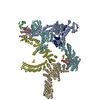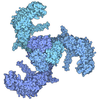[English] 日本語
 Yorodumi
Yorodumi- PDB-8je2: Cryo-EM structure of neddylated Cul2-Rbx1-EloBC-FEM1B complexed w... -
+ Open data
Open data
- Basic information
Basic information
| Entry | Database: PDB / ID: 8je2 | ||||||
|---|---|---|---|---|---|---|---|
| Title | Cryo-EM structure of neddylated Cul2-Rbx1-EloBC-FEM1B complexed with FNIP1-FLCN | ||||||
 Components Components |
| ||||||
 Keywords Keywords | LIGASE / Complex / E3 ubiquitin ligase / Cullin | ||||||
| Function / homology |  Function and homology information Function and homology information: / regulation of ubiquitin-protein transferase activity / positive regulation of B cell apoptotic process / epithelial cell maturation involved in prostate gland development / regulation of pro-B cell differentiation / negative regulation of lysosome organization / immature B cell differentiation / branching involved in prostate gland morphogenesis / Amino acids regulate mTORC1 / ATPase inhibitor activity ...: / regulation of ubiquitin-protein transferase activity / positive regulation of B cell apoptotic process / epithelial cell maturation involved in prostate gland development / regulation of pro-B cell differentiation / negative regulation of lysosome organization / immature B cell differentiation / branching involved in prostate gland morphogenesis / Amino acids regulate mTORC1 / ATPase inhibitor activity / B cell apoptotic process / regulation of DNA damage checkpoint / ubiquitin-dependent protein catabolic process via the C-end degron rule pathway / target-directed miRNA degradation / VCB complex / elongin complex / death receptor binding / regulation of extrinsic apoptotic signaling pathway via death domain receptors / negative regulation of TOR signaling / Cul5-RING ubiquitin ligase complex / SCF ubiquitin ligase complex / Cul2-RING ubiquitin ligase complex / SCF-dependent proteasomal ubiquitin-dependent protein catabolic process / ubiquitin ligase complex scaffold activity / TOR signaling / regulation of protein phosphorylation / Pausing and recovery of Tat-mediated HIV elongation / Tat-mediated HIV elongation arrest and recovery / HIV elongation arrest and recovery / Pausing and recovery of HIV elongation / positive regulation of TOR signaling / ubiquitin ligase complex / Tat-mediated elongation of the HIV-1 transcript / ubiquitin-like ligase-substrate adaptor activity / Formation of HIV-1 elongation complex containing HIV-1 Tat / Formation of HIV elongation complex in the absence of HIV Tat / RNA Polymerase II Transcription Elongation / Formation of RNA Pol II elongation complex / positive regulation of peptidyl-serine phosphorylation / RNA Polymerase II Pre-transcription Events / positive regulation of TORC1 signaling / B cell differentiation / intrinsic apoptotic signaling pathway / enzyme activator activity / cellular response to starvation / transcription corepressor binding / TP53 Regulates Transcription of DNA Repair Genes / transcription initiation at RNA polymerase II promoter / transcription elongation by RNA polymerase II / positive regulation of protein-containing complex assembly / Vif-mediated degradation of APOBEC3G / Inactivation of CSF3 (G-CSF) signaling / Evasion by RSV of host interferon responses / Oxygen-dependent proline hydroxylation of Hypoxia-inducible Factor Alpha / G1/S transition of mitotic cell cycle / Regulation of expression of SLITs and ROBOs / ubiquitin-protein transferase activity / Antigen processing: Ubiquitination & Proteasome degradation / positive regulation of proteasomal ubiquitin-dependent protein catabolic process / protein-folding chaperone binding / Neddylation / protein-containing complex assembly / ubiquitin-dependent protein catabolic process / protein-macromolecule adaptor activity / proteasome-mediated ubiquitin-dependent protein catabolic process / protein ubiquitination / lysosomal membrane / negative regulation of cell population proliferation / apoptotic process / ubiquitin protein ligase binding / regulation of transcription by RNA polymerase II / protein-containing complex binding / nucleolus / enzyme binding / negative regulation of transcription by RNA polymerase II / mitochondrion / nucleoplasm / metal ion binding / nucleus / cytosol / cytoplasm Similarity search - Function | ||||||
| Biological species |  Homo sapiens (human) Homo sapiens (human) | ||||||
| Method | ELECTRON MICROSCOPY / single particle reconstruction / cryo EM / Resolution: 3.63 Å | ||||||
 Authors Authors | Dai, Z. / Liang, L. / Yin, Y.X. | ||||||
| Funding support |  China, 1items China, 1items
| ||||||
 Citation Citation |  Journal: EMBO J / Year: 2024 Journal: EMBO J / Year: 2024Title: Structural insights into the ubiquitylation strategy of the oligomeric CRL2 E3 ubiquitin ligase. Authors: Zonglin Dai / Ling Liang / Weize Wang / Peng Zuo / Shang Yu / Yaqi Liu / Xuyang Zhao / Yishuo Lu / Yan Jin / Fangting Zhang / Dian Ding / Weiwei Deng / Yuxin Yin /   Abstract: Cullin-RING E3 ubiquitin ligase (CRL) family members play critical roles in numerous biological processes and diseases including cancer and Alzheimer's disease. Oligomerization of CRLs has been ...Cullin-RING E3 ubiquitin ligase (CRL) family members play critical roles in numerous biological processes and diseases including cancer and Alzheimer's disease. Oligomerization of CRLs has been reported to be crucial for the regulation of their activities. However, the structural basis for its regulation and mechanism of its oligomerization are not fully known. Here, we present cryo-EM structures of oligomeric CRL2 in its unneddylated state, neddylated state in complex with BEX2 as well as neddylated state in complex with FNIP1/FLCN. These structures reveal that asymmetric dimerization of N8-CRL2 is critical for the ubiquitylation of BEX2 while FNIP1/FLCN is ubiquitylated by monomeric CRL2. Our data present an example of the asymmetric homo-dimerization of CRL. Taken together, this study sheds light on the ubiquitylation strategy of oligomeric CRL2 according to substrates with different scales. | ||||||
| History |
|
- Structure visualization
Structure visualization
| Structure viewer | Molecule:  Molmil Molmil Jmol/JSmol Jmol/JSmol |
|---|
- Downloads & links
Downloads & links
- Download
Download
| PDBx/mmCIF format |  8je2.cif.gz 8je2.cif.gz | 289.5 KB | Display |  PDBx/mmCIF format PDBx/mmCIF format |
|---|---|---|---|---|
| PDB format |  pdb8je2.ent.gz pdb8je2.ent.gz | 201 KB | Display |  PDB format PDB format |
| PDBx/mmJSON format |  8je2.json.gz 8je2.json.gz | Tree view |  PDBx/mmJSON format PDBx/mmJSON format | |
| Others |  Other downloads Other downloads |
-Validation report
| Arichive directory |  https://data.pdbj.org/pub/pdb/validation_reports/je/8je2 https://data.pdbj.org/pub/pdb/validation_reports/je/8je2 ftp://data.pdbj.org/pub/pdb/validation_reports/je/8je2 ftp://data.pdbj.org/pub/pdb/validation_reports/je/8je2 | HTTPS FTP |
|---|
-Related structure data
| Related structure data |  36183MC  8ij1C  8je1C M: map data used to model this data C: citing same article ( |
|---|---|
| Similar structure data | Similarity search - Function & homology  F&H Search F&H Search |
- Links
Links
- Assembly
Assembly
| Deposited unit | 
|
|---|---|
| 1 |
|
- Components
Components
-Protein , 5 types, 5 molecules ABCDH
| #1: Protein | Mass: 87927.820 Da / Num. of mol.: 1 Source method: isolated from a genetically manipulated source Source: (gene. exp.)  Homo sapiens (human) / Gene: CUL2 / Production host: Homo sapiens (human) / Gene: CUL2 / Production host:  |
|---|---|
| #2: Protein | Mass: 11748.406 Da / Num. of mol.: 1 Source method: isolated from a genetically manipulated source Source: (gene. exp.)  Homo sapiens (human) / Gene: ELOB, TCEB2 / Production host: Homo sapiens (human) / Gene: ELOB, TCEB2 / Production host:  |
| #3: Protein | Mass: 11045.694 Da / Num. of mol.: 1 Source method: isolated from a genetically manipulated source Source: (gene. exp.)  Homo sapiens (human) / Gene: ELOC, TCEB1 / Production host: Homo sapiens (human) / Gene: ELOC, TCEB1 / Production host:  |
| #4: Protein | Mass: 70688.406 Da / Num. of mol.: 1 Source method: isolated from a genetically manipulated source Source: (gene. exp.)  Homo sapiens (human) / Gene: FEM1B, F1AA, KIAA0396 / Production host: Homo sapiens (human) / Gene: FEM1B, F1AA, KIAA0396 / Production host:  |
| #5: Protein | Mass: 131499.906 Da / Num. of mol.: 1 Source method: isolated from a genetically manipulated source Source: (gene. exp.)  Homo sapiens (human) / Gene: FNIP1, KIAA1961 / Production host: Homo sapiens (human) / Gene: FNIP1, KIAA1961 / Production host:  Homo sapiens (human) / References: UniProt: Q8TF40 Homo sapiens (human) / References: UniProt: Q8TF40 |
-Non-polymers , 1 types, 1 molecules 
| #6: Chemical | ChemComp-ZN / |
|---|
-Details
| Has ligand of interest | Y |
|---|
-Experimental details
-Experiment
| Experiment | Method: ELECTRON MICROSCOPY |
|---|---|
| EM experiment | Aggregation state: PARTICLE / 3D reconstruction method: single particle reconstruction |
- Sample preparation
Sample preparation
| Component | Name: Neddylated Cul2-Rbx1-EloBC-FEM1B complexed with FNIP1-FLCN Type: COMPLEX / Entity ID: #1-#5 / Source: RECOMBINANT |
|---|---|
| Source (natural) | Organism:  Homo sapiens (human) Homo sapiens (human) |
| Source (recombinant) | Organism:  |
| Buffer solution | pH: 7.5 |
| Specimen | Conc.: 1.93 mg/ml / Embedding applied: NO / Shadowing applied: NO / Staining applied: NO / Vitrification applied: YES |
| Vitrification | Cryogen name: ETHANE |
- Electron microscopy imaging
Electron microscopy imaging
| Experimental equipment |  Model: Titan Krios / Image courtesy: FEI Company |
|---|---|
| Microscopy | Model: FEI TITAN KRIOS |
| Electron gun | Electron source:  FIELD EMISSION GUN / Accelerating voltage: 300 kV / Illumination mode: FLOOD BEAM FIELD EMISSION GUN / Accelerating voltage: 300 kV / Illumination mode: FLOOD BEAM |
| Electron lens | Mode: BRIGHT FIELD / Nominal defocus max: 2000 nm / Nominal defocus min: 1500 nm |
| Image recording | Electron dose: 50 e/Å2 / Film or detector model: GATAN K3 BIOQUANTUM (6k x 4k) |
- Processing
Processing
| CTF correction | Type: PHASE FLIPPING AND AMPLITUDE CORRECTION |
|---|---|
| 3D reconstruction | Resolution: 3.63 Å / Resolution method: FSC 0.143 CUT-OFF / Num. of particles: 433719 / Symmetry type: POINT |
 Movie
Movie Controller
Controller




 PDBj
PDBj













